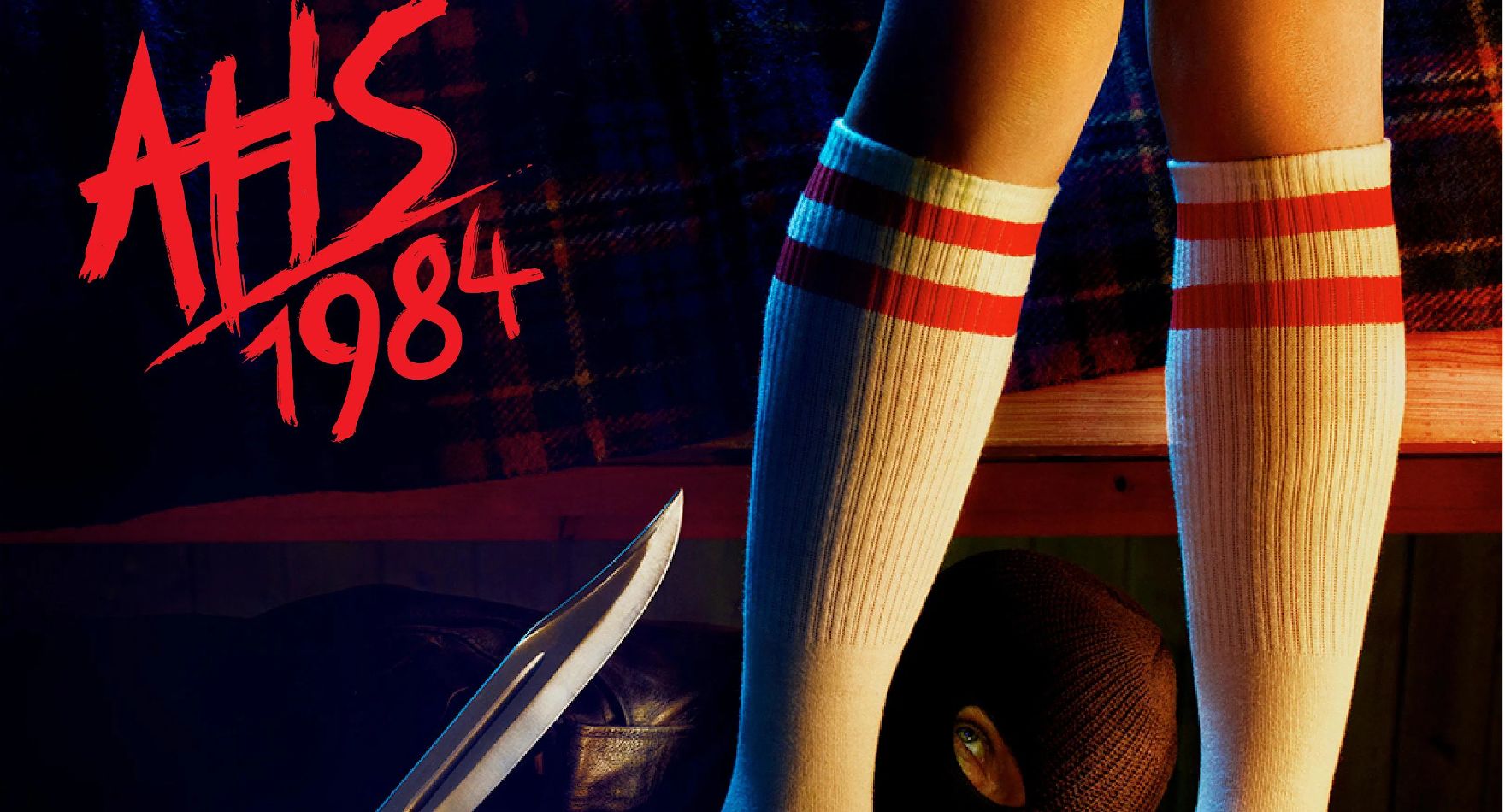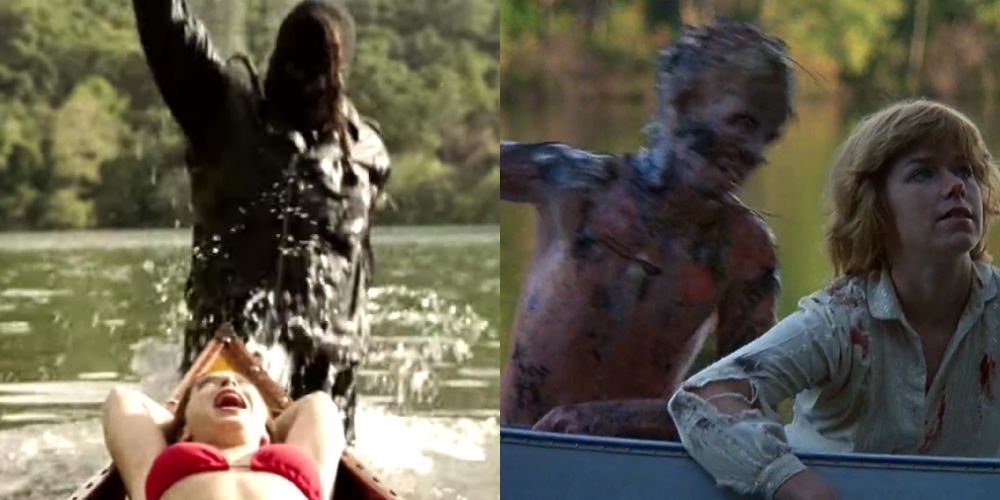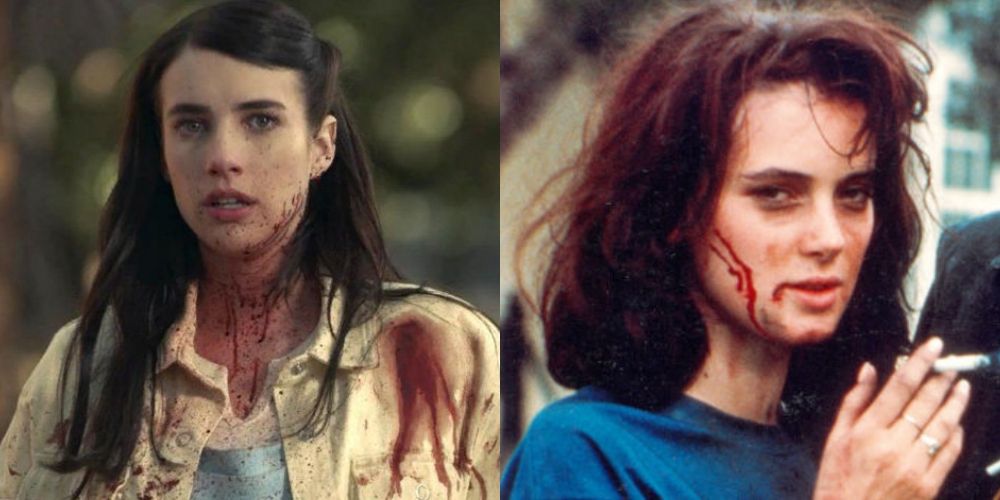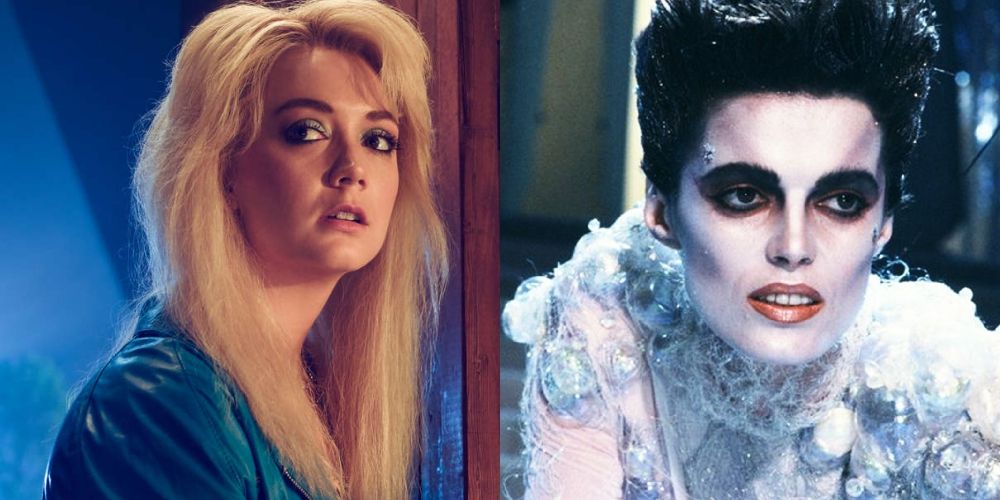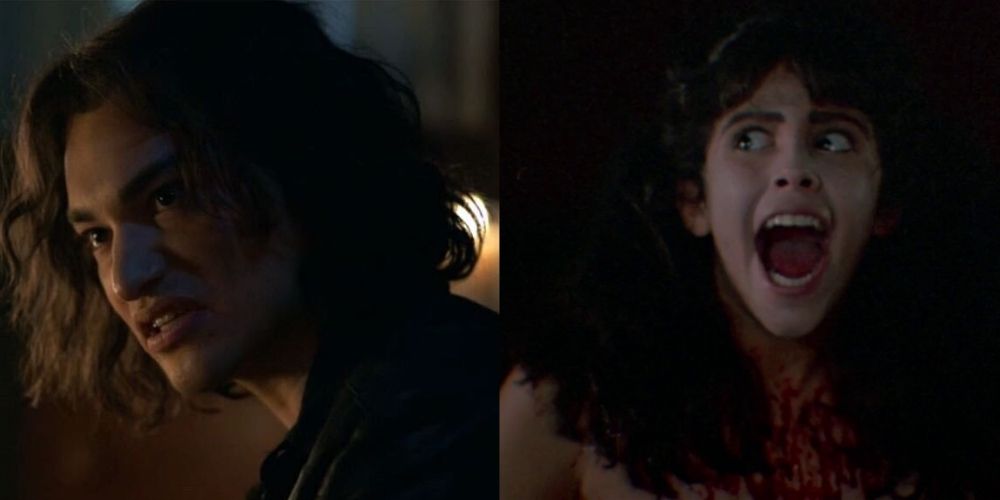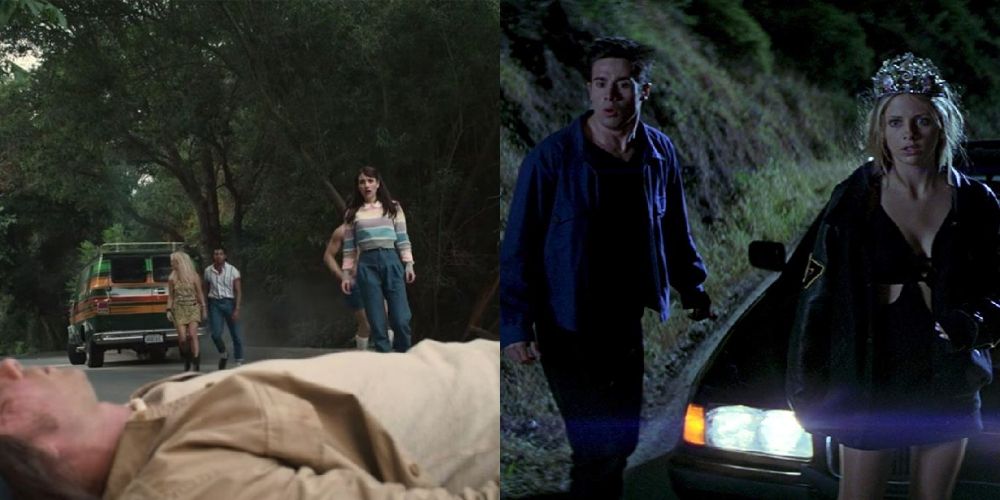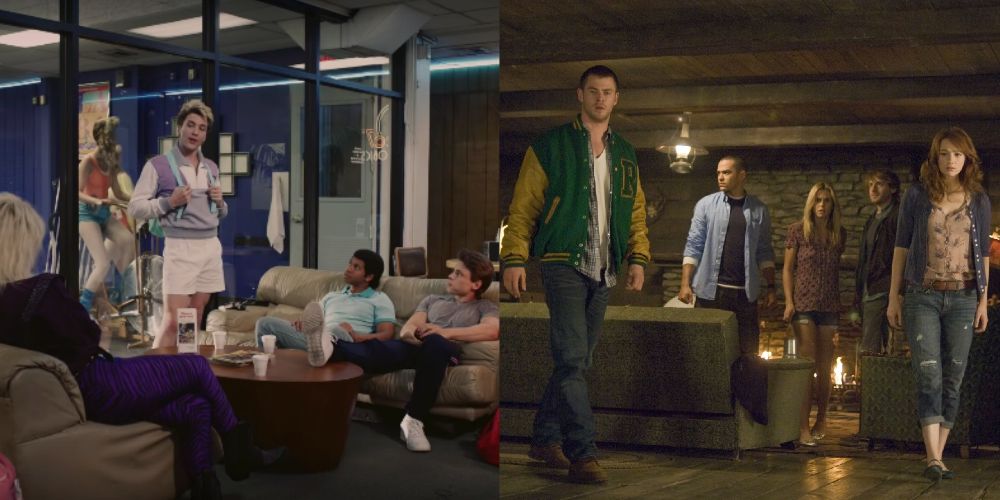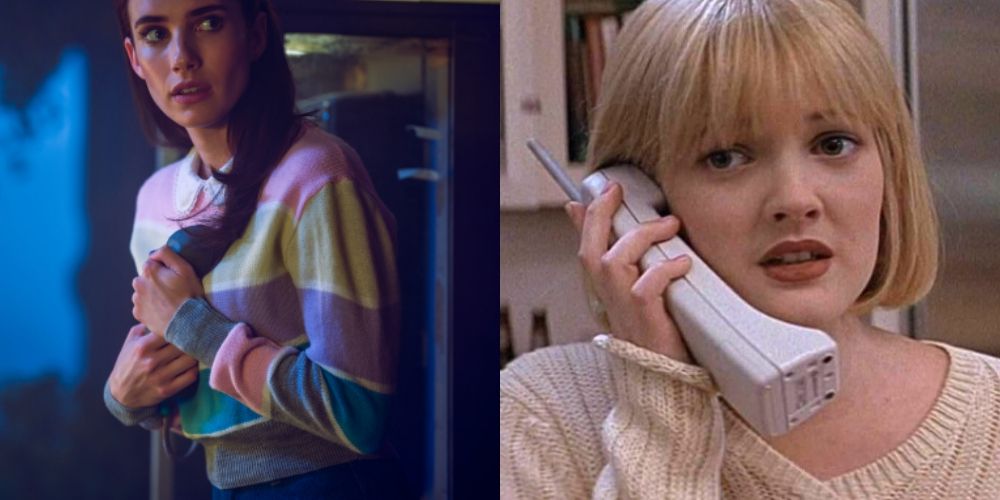With its mix of camp and horror, the ninth season of American Horror Story has given fans the series' signature stylized, theatrical approach to scary stories. Set in 1984, the 2019 season is full of aerobics, new wave music, big hair, pastel denim, and sharp knives. The show delves into what life was like the year Richard Ramirez terrorized Southern California, as well as what a group of 20-somethings find when they decide to spend the summer as camp counselors in order to avoid the chaos in the city.
Like the other seasons before it, American Horror Story: 1984 is stock full of homages and references to horror films. Whether it's through dialogue, characters, settings, or mood, Ryan Murphy, the show's creator, always makes his source material known to fans who pay attention. Some of the horror movie references on this list are more obvious than others, but they all add the 1984's slasher, B-movie vibes.
Friday The 13th
One of the more obvious parallels between Friday the 13th, a 1980 slasher cult classic, and 1984 is that both take place at a summer camp along a lake: Camp Crystal Lake in the film, and Camp Redwood in the show.
Friday the 13th follows a group of drinking and drugging camp counselors as they are brutally murdered by an unknown mad person with a giant knife. The killer turns out to be Pamela Voorhees, the mother of Jason Voorhees, a young camper who drowned due to negligence. Benjamin Richter, also known as Mr. Jingles, has a similar storyline in 1984, and both the film and the show include suspenseful killer reveals.
Heathers
This 1988 dark comedy influenced by slasher films is about a pair of disaffected, blood-hungry teenagers who get a taste for murder after poisoning one of their friends with drain cleaner. The pair, JD and Veronica, participate in an absurd and nihilistic romance.
Romances are portrayed in 1984 in a way similar to Heathers. When Brooke's wedding day turns into a blood bath, the influence of Heathers is obvious. When aerobics instruction Montana Duke has a twisted love affair with Richard Ramirez, the influence is obvious. Like the romance between JD and Veronica, things end with a major bang between these 1984 couples. There's not a quiet farewell to be found.
Ghostbusters
After those killed at Camp Redwood come back as ghosts in 1984, they joke around in the nether world like characters from one of the great horror comedies of the 1980s, Ghostbusters. While there's no Slimer in 1984, there are a lot of angry spirits ready to get vengeance for their deaths.
In fact, after ghost Montana kills a cop, she jokingly says, "There is no Montana, only Zuul." This is, of course, a reference to the demigod the Ghostbusters must defeat in the first movie. It seems Montana is trying to make the most out of purgatory by quoting a line from a movie that came out the year the show takes place.
Sleepaway Camp
Sleepaway Camp is a low budget B-horror film released in 1983. While it may seem, from the surface, like a typical slasher, what makes this film stand out from the rest is its inclusion of queer characters. Throughout it's run, American Horror Story has been hailed for this kind of inclusivity, too.
This film IS another summer camp fright fest, but, like American Horror Story, it combines sex with horror, giving it a more interesting edge. 1984 blends intimacy and death through its fictionalized addition of real-life serial killer Richard Ramirez, who brings these themes to life through his relationships with both Margaret and Montana, as well as his relationships with those he stalks.
I Know What You Did Last Summer
Even though it's not an 80s flick, I Know What You Did Last Summer contains an infamous hit and run scene reproduced in the first episode of 1984. In the movie, a group of college-aged young adults hit a man driving home from a party on a rainy night. Their choice to flee the scene of the crime comes back to haunt them in many ways.
In 1984, the crew, on their way to Camp Redwood, hit a man who jumps out into the middle of the street. They spend a few minutes deciding whether they should stay or go, but they ultimately decide to see what's going on. Eventually, they find out the man they hit is actually not a man, but a ghost.
The Cabin In The Woods
This meta-horror gem from 2012 is full of twists and turns that won it critical acclaim. It contains layered, complex plot lines that mirror the action that unfolds intricately in 1984.
The Cabin in the Woods is about a group of college students who take a spring break to a cabin, imagine this, in the woods. It turns out, though, they are all participants in a ritual to appease ancient, blood-thirsty gods. Talk about a story arc! While 1984 doesn't include any ritualistic human sacrifice, it does include characters who aren't what they seem, plot lines that go slant with no warning, and a group of clueless dolts trying to figure out what's going on.
Carrie
Brian de Palma's famous adaption of Stephen King's novel Carrie is a horror classic, following an abused and shelter teenager with psychic powers who loses it when her high school bullies go too far. While 1984 doesn't have a prom scene where a young woman is covered in blood, it does have a middle-aged overbearing religious zealot: Margaret Booth.
The sole survivor of Mr. Jingles' attack in 1969, Margaret claims to have reopened Camp Redwood in 1984 in order to transform a place where so much death occurred into a site of beauty and hope. As it goes with much of American Horror Story, Margaret is not who she seems, and she mirrors Carrie's mother with her religious dogmatism and violent retribution. It's no coincidence Carrie's mother is also named Margaret.
The Texas Chainsaw Massacre
There are no Texas cannibals in 1984, but there is plenty of bloodshed. The Texas Chainsaw Massacre follows the Sawyer Family as they hunt down, butcher, and feast upon those unfortunate enough to stumble onto their property. Leatherface, donning a mask made out of human flesh, does most of the hard labor by chasing people around with chainsaws until they succumb to his will and his blade.
The original The Texas Chainsaw Massacre film includes a very influential hitchhiking sequence with a group traveling in a van, and the van driven by Xavier in 1984 looks very similar in style to the van from the movie.
Halloween
What many critics claim to be the best slasher film ever made, Halloween is a low-budget classic that made one of the most horrific horror movie villains a household name: Michael Myers.
The parallels between Halloween and 1984 are plentiful. Halloween contains the quintessential final girl, Laurie Strode, and it's obvious Emma Roberts took some lessons from Jamie Lee Curtis when bringing her own final girl, Brooke, to life. Both Halloween and 1984 contain their own boogeymen: Michael for the former and Mr. Jingles for the latter. Michael may be a bit more one-dimensional than Mr. Jingles, but the influence is still obvious.
Scream
"Do you like scary movies?" Phones play an important role in both Scream, Wes Craven's slasher parody, and 1984. Ghostface, the villain in the Scream films, usually lets his victims know he's on the way to slaughter them by phoning them first.
The killer-calling-their-victim trope has been around for quite some time, but Wes Craven made it gorier and more effective than anyone before him. In 1984, the ringing payphone Brooke is compelled to pick up in the first episode, and what she hears on the other line, fills the scene with some serious Scream vibes.

